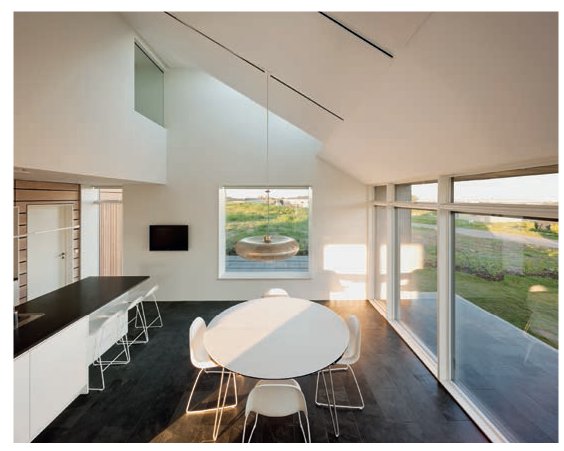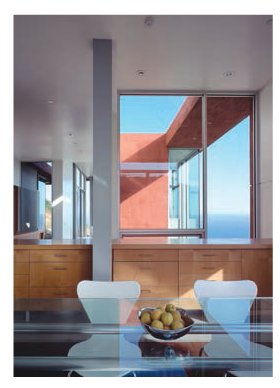Active solar systems employ mechanical means to generate energy, which distinguishes them from methods that include passive principles. As energy costs rise, living ‘off the grid’ or consuming very little power has become attractive to designers and homeowners alike. In addition, recent technological innovations have made active solar power systems costcompetitive with conventional ones, and have lowered their pay-off period to between five and 15 years (Strongman 2008).
An important part of an active solar system is its harvesting method. They can be arbitrarily sorted into two categories: those that produce electrical power and those that produce thermal energy. Electricity-producing systems are typically silent, environmentally friendly and low maintenance with an expected lifetime of more than 20 years (Strongman 2008). Common electricity-producing systems consist of photovoltaic (PV) panels, which are mounted on rooftops, within curtain walls or on separate structures. Such systems, however, are already beginning to be replaced by thin-film solar sheets, which, despite currently being less efficient than PV panels, are considerably more aesthetically pleasing, versatile and almost 50 per cent more affordable due to their ability to be mass-produced (Williams 2008, Bergethon 2011). Alternatively, thermal solar collectors are less expensive, simple and also common (Friedman 2007, Sassi 2006). They can be either water- or air-based and they distribute heat harvested from the sun. There are many applications for these systems, such as space, washing and pool water heating, as well as for cooking and water desalinization.
An important aspect of solar-powered homes is their energy storage systems. Depending on the energy collection method chosen, the systems needed to transfer and store the energy can vary greatly. Storage of electrical energy, for example, depends primarily on whether the dwelling is off-grid or grid-tied. Offgrid systems require a battery storage facility and, potentially, special appliances, while a grid-tied system requires additional hardware (Sassi 2006). Conversely, thermal energy requires a heat store, which can be located in multiple places such as the basement, a solar storage tank or even the heat collector itself (Tanha 2010, Gonchar 2010, Friedman 2007). In addition, thermal systems must also transfer the energy efficiently to the designated storage device. Various appliances such as fans, pumps and valves can aid in this transfer.
The third and final aspect to consider when designing solar-powered dwellings is maximizing energy input through proper orientation. Factors such as solar intensity and duration of solar exposure need to be calculated using tools such as sun-path diagrams to find the most suitable angle and orientation (Tanha 2010). Furthermore, a shading analysis also needs to be performed to avoid shadows being cast on the collectors from adjacent buildings or trees. In addition, solar tracking devices can be used to rotate the panels towards the sun and therefore greatly increase their input during the morning and evening hours.
A highly important aspect of a solar-powered dwelling is its electricity-producing systems. Production occurs when solar radiation excites the electrons within a semiconducting material – typically silicon – and subsequently generates direct current. The three systems that use this process are monocrystalline PV panels, polycrystalline PV panels and ribbon silicon panels, or thin-film solar panels (Sassi 2006, Quantum Solar Power 2011). For many years, monocrystalline panels dominated the market due to their durability, and they had typical efficiencies of between 15 and 20 per cent; however, newer versions can reach as high as 34 per cent (Quantum Solar Power 2011, Smith 2003).
Nevertheless, ribbon silicon panels, commonly known as thin-film solar panels, are preferable to monocrystalline panels. The wafer-thin modules are manufactured by applying layers of a semiconducting component to inexpensive materials such as glass, plastic or metal. While they only have an efficiency of 6 to 11 per cent, with experimental versions reaching 21 per cent, they are still 50 per cent more affordable (Bergethon 2011, Williams 2008, Quantum Solar Power 2011). Houses have already been constructed with solar-panel shingles, peel-andstick wall sheets and spray-on solar sheets, which even have the potential to be applied to clothes (Lovgren 2005, Lumeta 2011, Williams 2008).
Active thermal collectors are another key component of solar dwellings that gather radiated heat. There are two types of system, the first, active air-based collectors, consist of either a perforated cladding system or a glazed-panel air-heating system (Graham 2011, Solar Air Heating 2011). The perforated cladding system is more popular and consists of dark, unglazed metal plating, which replaces the exterior wall siding. These panels have thousands of small holes through which air is drawn in by fans. When exposed to sunlight, they heat up and transfer the heat into a 1 mm (0.04 in) thick cushion of air, which is drawn into the building and either circulated through the spaces via a heating, ventilation and air-conditioning (HVAC) system, or stored in a thermal well (Graham 2011). These systems are highly effective and can reach a 60 per cent efficiency rate with temperature gains exceeding 23°C (41.4°F) over ambient temperatures on sunny days (MatrixAir 2009).
The glazed-panel system consists of a metal case with dark tubes, covered by a transparent Plexiglass sheet. With the aid of fans, fresh air is drawn into the tubes and gains heat, which can then be transferred to either the indoors via the HVAC system or to a thermal well (Graham 2011). This system can have efficiencies from 20 per cent up to 80 per cent depending greatly upon the general set-up, design and factors such as air speed and air pressure (Solar Air Heating 2011). With the average payback period for both solar air-heating technologies being only two to five years, such a system is a viable method of reducing the electrical or fossil fuel load consumed by ‘non-green’ houses (Graham 2011).
•High energy costs
•Drop in the cost of solar panels
•Government incentives
•Technological advancement
INNOVATIONS
•Improvement in energy storage methods
•Solar panels with tracking devices
•Development of solar shingles for residential use
•Development of the evacuated tube solar method
Active water-based thermal collecting systems are more commonly used systems and comprise of either a flat-plate collector or an evacuated-tube collector (Strongman 2008, Sassi 2006). The flat-plate collector is the more commonly used of the two and consists of a series of copper tubes passed inside a glass-covered metal frame that forms an insulated box (Johnston and Gibson 2010). Such systems can reach up to 85 per cent efficiency on commercial models, with only 12 per cent of solar radiation being emitted back into the atmosphere by the panels (Bosch 2011). This system can produce temperatures up to 30°C (54°F) above ambient temperature.
The evacuated-tube collector is a more advanced and efficient technology that consists of parallel rows of large glass tubes filled with small amounts of antifreeze sealed a small central copper pipe. When heated by the sun, the antifreeze converts to steam, rises to the top of the tube and transfers its heat to collector heads before condensing back into liquid to be reheated (Strongman 2008, Johnston and Gibson 2010). This system is also able to take advantage of passive solar tracking due to the fact that the sun’s radiation makes contact with tubes, rather than a flat surface. The flat surface has very little solar exposure during the start and end of the day because of the small angle between the plane of the plate and the incoming solar rays. This angle is known as the ‘incidence angle modifier’ (IAM). A rounded tube will consistently have a direct, perpendicular angle between the incoming rays which equates to an approximately 25 per cent increase in heat output performance, when compared to flat-plate collectors, solely from passive solar tracking (Solar Panels Plus 2007). Overall, while flat-plate collectors can only produce temperatures up to 30°C (54°F) above ambient temperature, evacuated tube collectors can reach temperatures of 100°C (212°F). Such efficiency, however, comes with an increased price tag, which tends to make these panels more appropriate for colder climates (Johnston and Gibson 2010). It must also be noted that most solar thermal systems are only guaranteed for five to ten years and, according to Strongman (2008), should be budgeted accordingly.
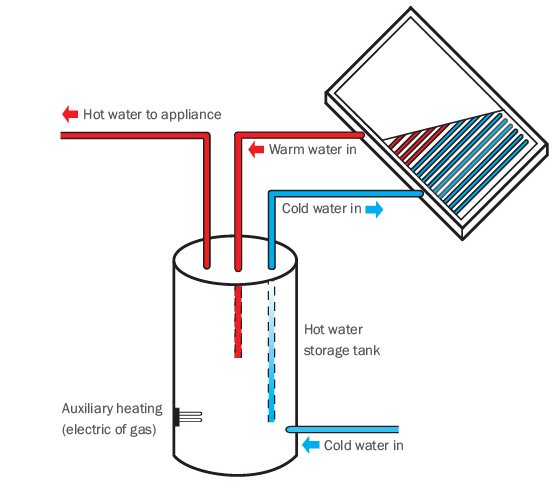
Figure 13.1:Components of a waterheating solar-based system.
As the technology continues to advance and more efficient systems are introduced, it is becoming clear that the number of homeowners switching to solar power will only increase with time. These systems are poised not only to save money, but also to protect the environment from the harmful affects of mining, transportation, burning fossil fuels and the waste of nuclear energy production.

Figure 13.2:Components of evacuated tube collectors.
13.1 ACTIVE SOLAR-POWERED DWELLINGS |
|
Project |
Home for Life/Activehouse |
Location |
Lystrup, Aarhus, Denmark |
Architect |
AART Architects |
Based on the principles of Passivhaus, this house, designed by the Danish firm AART Architects and built by the developer VKR Holding gathers energy from the sun using solar means and a storage system. The home has one-and-a-half storeys, and is powered by 7 m2 (75 sq ft) solar collectors for space and water heating. At the same time, 50 m2 (538 sq ft) of photovoltaic (PV) solar cells generate more than the entire dwelling’s electrical consumption. By producing more energy than needed, the occupants of the 200 m2 (2,153 sq ft) area dwelling are able to sell energy to the local electrical power company during summer months and supplement their needs from the grid during winter when additional energy is needed. While the walls are well insulated, and the windows are mechanized for ventilation, the under-floor coil heating offers a comfortable temperature that is generated by heat pumps.
Combined, these systems create an energy surplus of 9 to 15 kWh/m2 (2,800 to 4,600 BTU/sq ft) per year. Working in conjunction with one another, photovoltaic cells supplement electricity usage even when the sun doesn’t shine.
The window area is equivalent to 40 per cent of the total floor area, which is twice the ratio of a conventional home. A notable design intention was to maximize sunlight penetration to help reduce the use of artificial light and generated heat. In addition, by having at least two different angled window openings in each room, the indoor environment fosters a healthy lifestyle for the occupants.

The dwelling was designed based on principles of the German Passivhaus standards.

The house is powered by solar collectors for space and water heating.
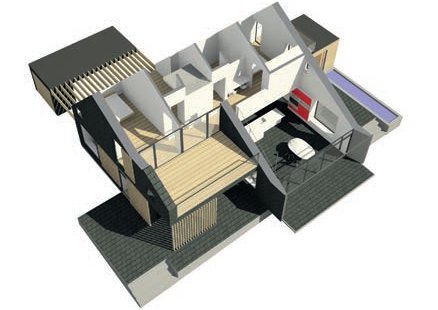
Bird’s-eye view of the first floor.
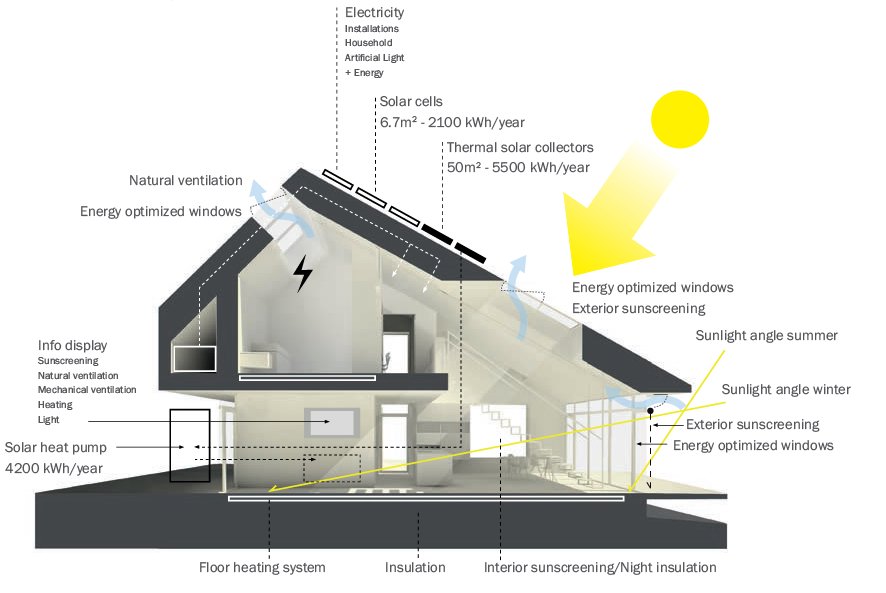
Indoor air is controlled by a computer system which monitors temperature, humidity and CO2 level.
Interior materials were chosen to foster a healthy indoor environment.
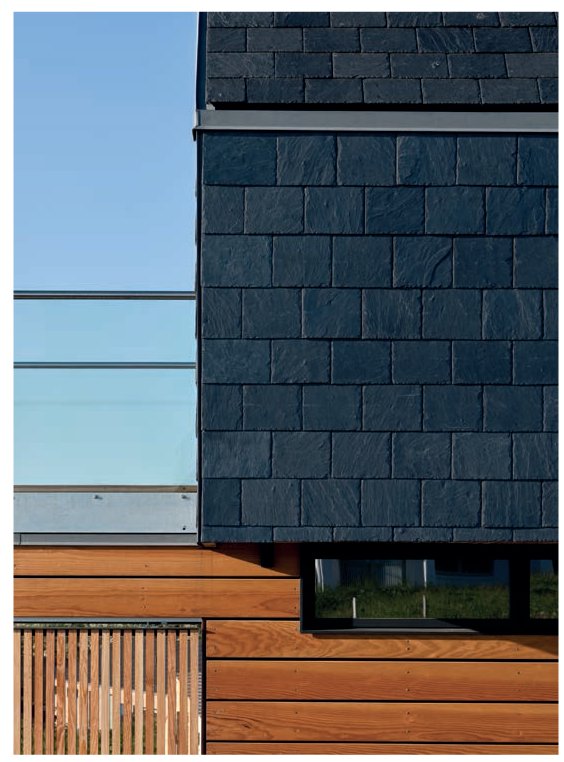
The timber frame envelope fosters high insulation levels.
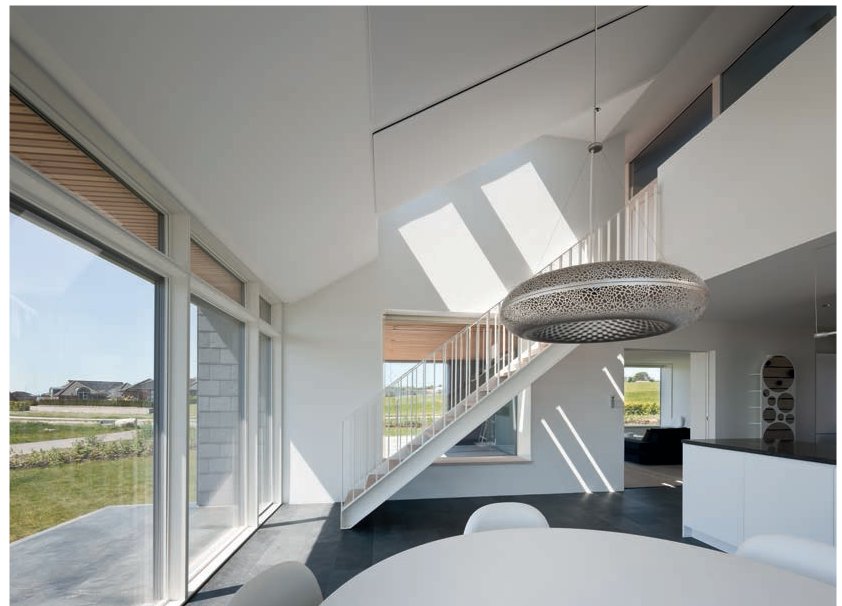
The high-quality windows are mechanized for ventilation.
The construction of Activehouse followed a traditional method. The timber frame, with U-values of 0.10 for the walls and 0.07 for the floor and roof, is clad with stone slabs. Indoor air is controlled by a computer system, which monitors temperature, humidity and CO2 levels. Windows, openings and light switches are also adjusted by the system to regulate indoor air based on internal use to provide constant and comfortable settings for the occupants. Calculations by engineers have shown that in less than 40 years, the Activehouse will have produced enough energy to offset the amount consumed for its original construction materials and production. By that time, when the supply of petroleum runs dry and the market demand for electrical cars reaches its full potential, the dwellers will have gained enough natural energy to spare. With strong strategies focusing on long-term usability, the Activehouse is a successful integration of both the sun’s energy and comfortable living.
13.2 ACTIVE SOLAR-POWERED DWELLINGS |
|
Project |
Malibu 5 |
Location |
Malibu, California, USA |
Architect |
Kanner Architects |
Malibu 5, a house designed by the Californian firm Kanner Architects, features both photovoltaic cells and solar water heaters on its roof. Overall, its minimalistic facade and simple geometry represent a livable and sustainable dwelling. Located on a hillside in Malibu, the house faces the Pacific coast and is strategically designed for passive and active solar gains, natural ventilation and ample views.
Essentially conceived as two interlocking C-shaped rectangles, the 200 m2 (3,300 sq ft) area of the living space is powered by photovoltaic panels during the day. In fact, the building generates excess electricity to feed the local power grid.
The house was constructed from starched-plaster and concrete floors layered on the ground level. During the day, the floors act as heat storage, gaining the sun’s energy and releasing it during the cooler nights. Water heaters on the roof also contribute to the radiant floor heating, providing comfortable living temperatures even during cooler days. With large openings to the surrounding views, all the windows are doubled-paned, low-e glass, filled with argon, which can be hermetically sealed to insulate the house on warm and cool days. When interior rooms are flooded with natural light, the house also minimizes the use of artificial lighting.
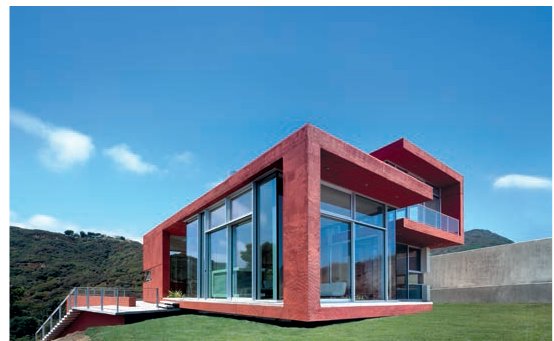
The home is located on a hillside in Malibu, California.
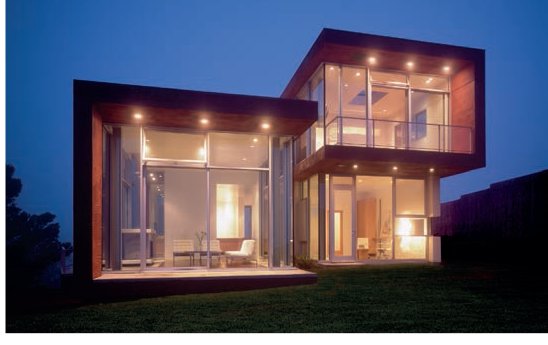
South facade of Malibu 5 illuminated at night.
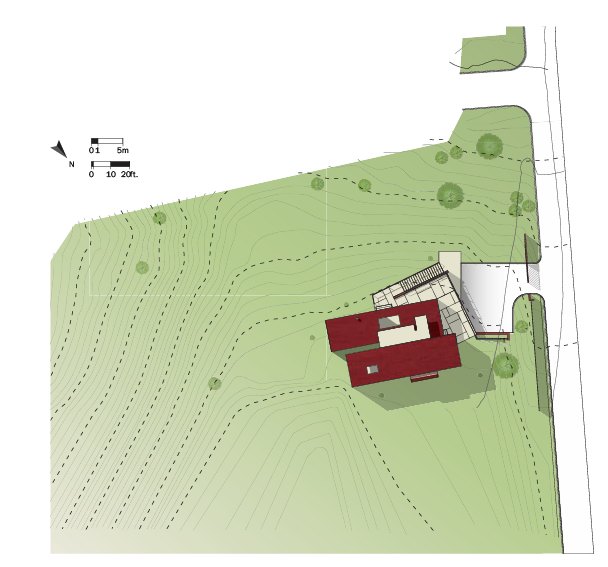
The house was strategically sited for active solar gain.
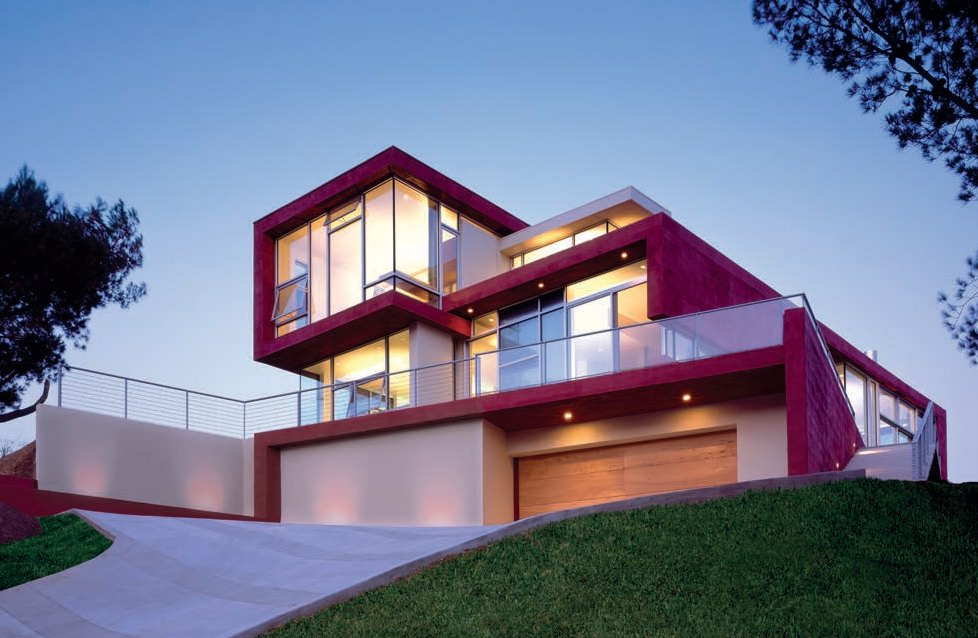
The dwelling was constructed with plaster walls.
In addition, the design’s vertical stack effect allows the interior space to have natural cross ventilation between the two floors. In the hotter seasons, passive cooling is induced by the coastal breezes and helps to lower the occupants’ demand for energy.
The large windows let in natural light, which reduces a need for artificial illumination.
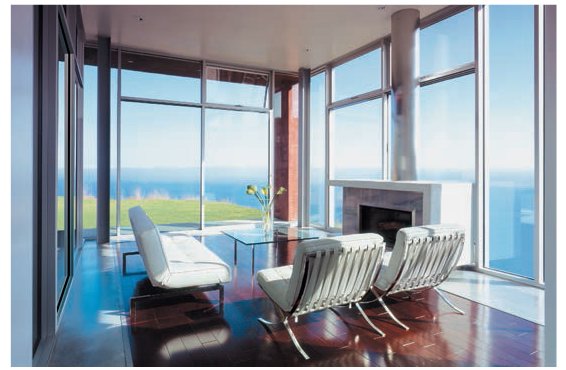
All the windows are low-e argon filled.
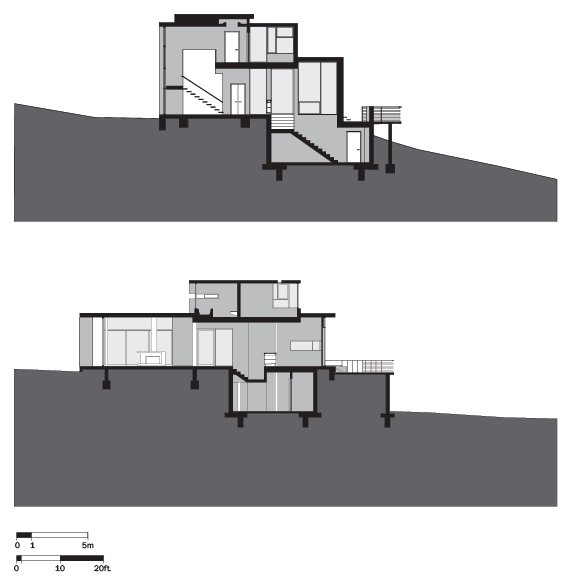
Section showing how well the dwelling was integrated with its surroundings to reduce its profile.
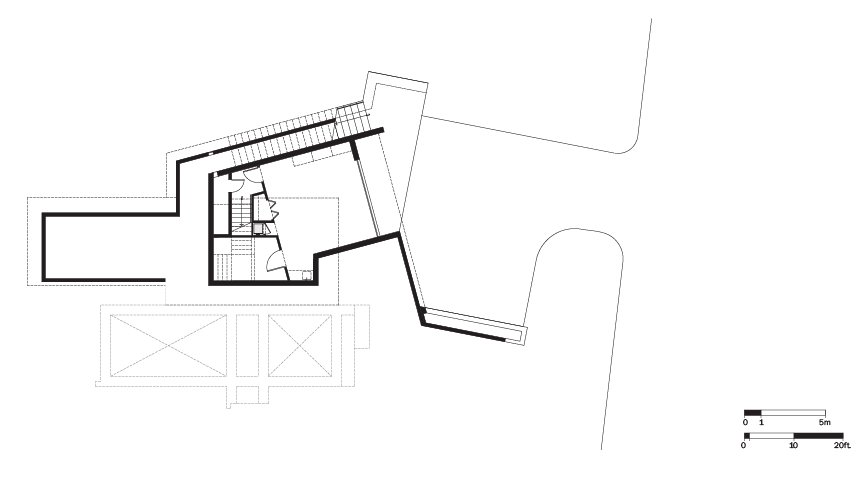
The garage is built into the hill.
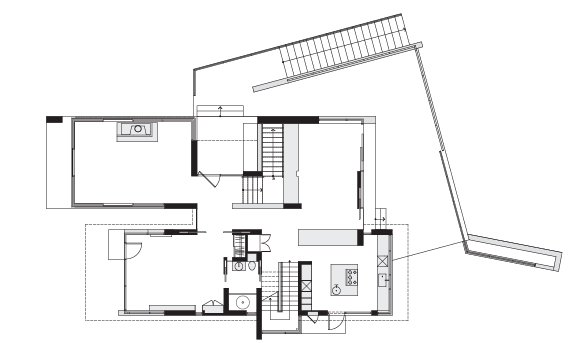
Ground floor plan.
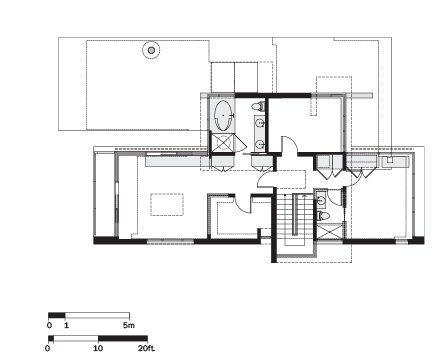
The first floor houses the bedrooms.

